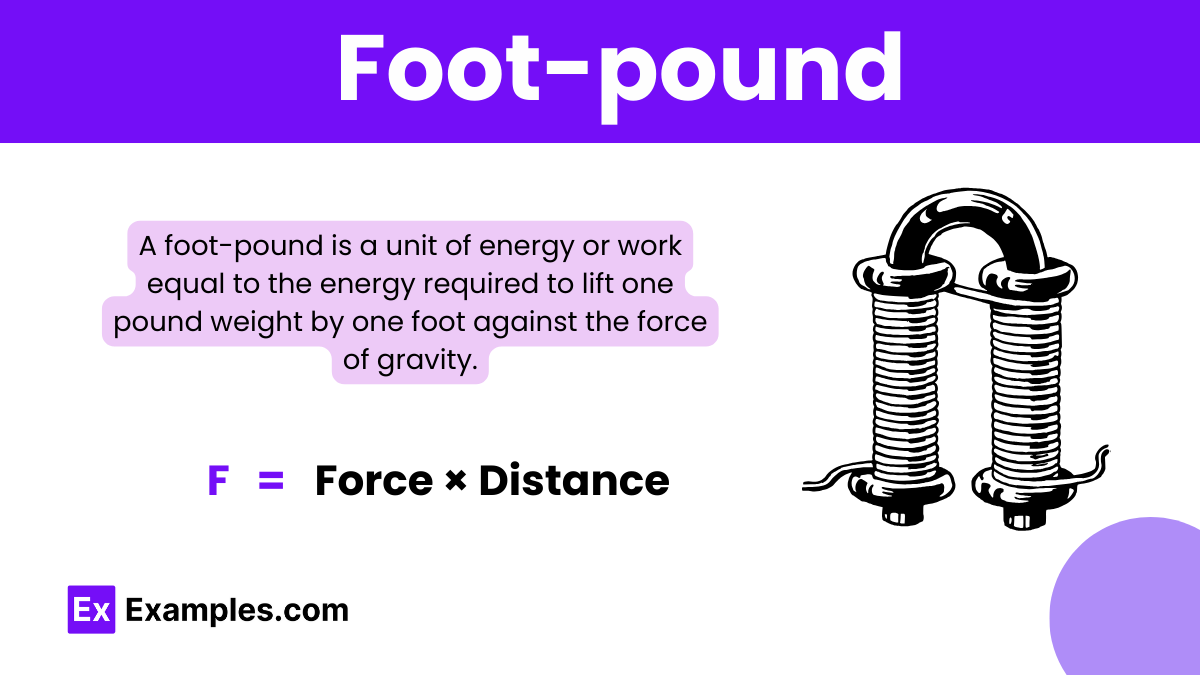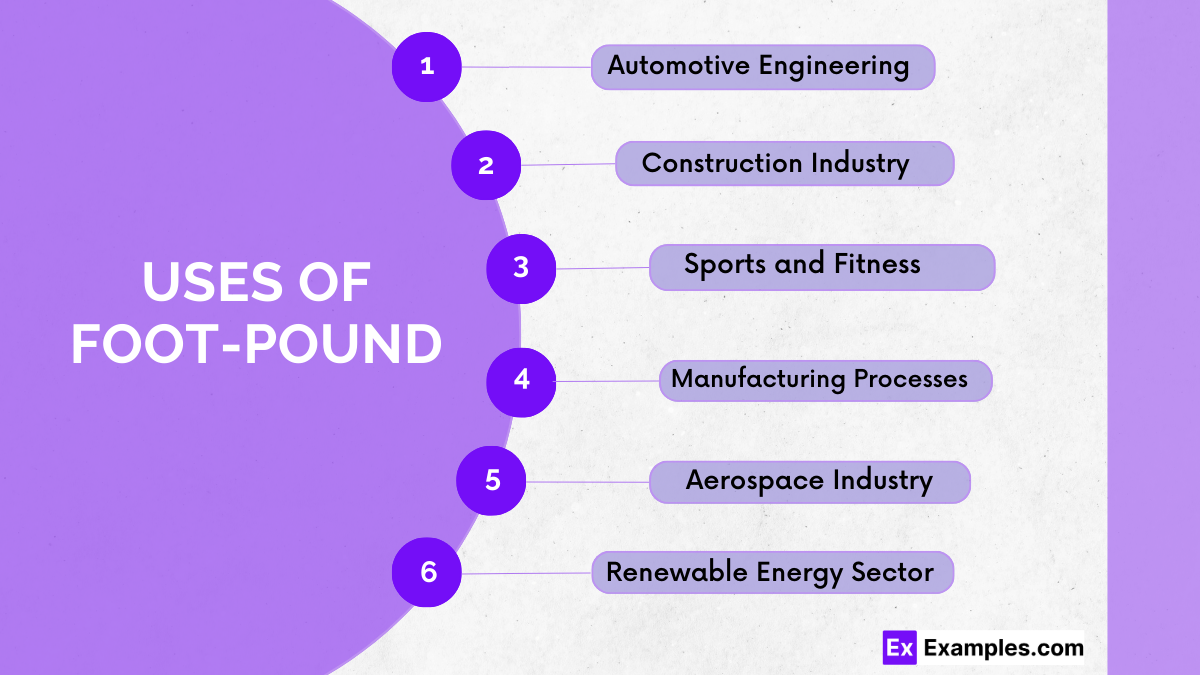What does the unit foot-pound measure?
Force
Work or energy
Power
Pressure


F = Force × Distance
| Unit | Symbol | Prefix | Value |
|---|---|---|---|
| Kilofoot-pound | kft-lb | kilo- | 1 kft-lb=1000 ft-lb |
| Megafoot-pound | Mft-lb | mega- | 1 Mft-lb=106 ft-lb |
| Gigafoot-pound | Gft-lb | giga- | 1 Gft-lb=109 ft-lb |
| Terafoot-pound | Tft-lb | tera- | 1 Tft-lb=1012 ft-lb |
| Petafoot-pound | Pft-lb | peta- | 1 Pft-lb=1015 ft-lb |
| Exafoot-pound | Eft-lb | exa- | 1 Eft-lb=1018 ft-lb |

| From/To | Conversion Factor | Example |
|---|---|---|
| Foot-pound to Joules (J) | 10 ft-lb = 1.35582 J | 10 ft-lb = 13.5582 J |
| Foot-pound to Calories (cal) | 10 ft-lb = 0.323831 cal | 10 ft-lb = 3.23831 cal |
| Foot-pound to Kilowatt-hours (KWh) | 10 ft-lb = 0.000376616 kWh | 10 ft-lb = 0.00376616 kWh |
| Foot-pound to Ergs (ergs) | 10 ft-lb = 135581 ergs | 10 ft-lb = 1.35581×10⁶ ergs |
| Foot-pound to British Thermal Unit (BTU) | 10 ft-lb = 0.00128507 BTU | 10 ft-lb = 0.0128507 BTU |
| Foot-pound to Watt-hours (Wh) | 10 ft-lb = 0.000376616 Wh | 10 ft-lb = 0.00376616 Wh |
| Foot-pound to Kilocalories (kcal) | 10 ft-lb = 0.000323831 kcal | 10 ft-lb = 0.00323831 kcal |
| Foot-pound to Electronvolts (eV) | 10 ft-lb = 2.24978×10¹⁹ eV | 10 ft-lb = 2.24978×10²⁰ eV |
| Foot-pound to Megajoules (MJ) | 10 ft-lb = 1.35582×10⁻³ MJ | 10 ft-lb = 1.35582×10⁻² MJ |
| Foot-pound to Gigawatt-hours (GWh) | 10 ft-lb = 3.768×10⁻¹⁰ GWh | 10 ft-lb = 3.768×10⁻⁹ GWh |

Understanding foot-pounds can help individuals grasp the effort required to perform tasks such as tightening screws, lifting weights, or operating machinery, contributing to better comprehension of mechanical principles in daily life.
Foot-pounds offer a practical measurement of torque in industries where English units are commonly used. While other torque units exist, such as newton-meters, foot-pounds remain prevalent in certain applications due to historical and practical reasons.
Engineers use foot-pounds to evaluate the performance and efficiency of mechanical systems, ensuring components are designed to withstand specified loads and operate effectively within given parameters.
Text prompt
Add Tone
10 Examples of Public speaking
20 Examples of Gas lighting
What does the unit foot-pound measure?
Force
Work or energy
Power
Pressure
Which of the following correctly defines one foot-pound?
The force needed to move an object one foot
The work done by a one-pound force moving an object one foot
The power to move one pound one foot per second
The pressure exerted by one pound on one foot
Convert 10 foot-pounds to joules. (1 foot-pound = 1.356 joules)
13.56 joules
135.6 joules
1.356 joules
0.1356 joules
If a force of 5 pounds moves an object 3 feet, how much work is done in foot-pounds?
15 foot-pounds
5 foot-pounds
3 foot-pounds
8 foot-pounds
How many foot-pounds of work are done when lifting a 20-pound object 4 feet?
80 foot-pounds
24 foot-pounds
16 foot-pounds
40 foot-pounds
What is the equivalent of 50 foot-pounds in joules? (1 foot-pound = 1.356 joules)
67.8 joules
50 joules
75.6 joules
25.6 joules
A motor exerts a torque of 30 foot-pounds. What is this torque in newton-meters? (1 foot-pound = 1.356 newton-meters)
40.68 newton-meters
20.4 newton-meters
30.0 newton-meters
50.4 newton-meters
Which of the following activities typically involves work measured in foot-pounds?
Running a marathon
Turning a wrench
Calculating pressure in a tank
Measuring electrical resistance
If an engine delivers 100 foot-pounds of torque, how much is this in joules? (1 foot-pound = 1.356 joules)
135.6 joules
100 joules
200 joules
250 joules
What is the work done in foot-pounds when a 10-pound force moves an object 2 feet?
20 foot-pounds
5 foot-pounds
10 foot-pounds
25 foot-pounds
Before you leave, take our quick quiz to enhance your learning!

